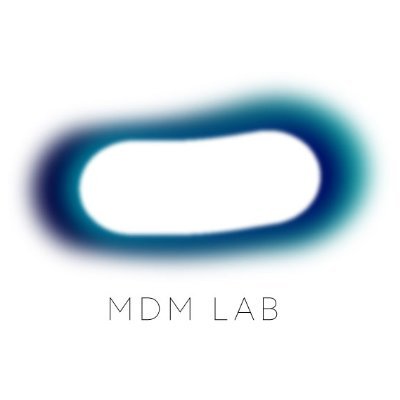
MDMLab
@MDMlab_Paris
Followers
2K
Following
218
Media
83
Statuses
264
Molecular Diversity of Microbes Lab @institutpasteur // Focusing on bacterial immunity 🦠🧬🧫 // We ♥️ sharing our science with everyone // PI @AudeBer
Paris
Joined May 2022
Out in @cellhostmicrobe: Conservation of antiviral systems across domains of life reveals immune genes in humans. Using phylogenomics, we traced antiphage systems in eukaryotes, predicted human homologs and validated their immune function in human cells! https://t.co/QSypd5HPnC
cell.com
A subset of eukaryotic immune proteins originates from antiphage systems protecting bacteria from viruses. Cury et al. demonstrate that homology search of antiphage systems in eukaryotic genomes can...
6
58
145
This is a very important study! Congrats to all authors 👏
Out @NatureMicrobiol, we predicted phage-bacteria interactions in E. coli species using only genomic information. Adsorption, not defense systems, is the main driver at this scale (relevant for a phage therapy context), leading to tailored cocktails! https://t.co/8SKwz5wFrk 🧵👇
1
1
10
💻🧫New preprint: How accurately can we predict diverse phage bacteria-interactions from their genomes only ? We created a matrix of >38k phage-bacteria interactions to find out (=> AUROC 86%) & used our predictions to recommend tailored phage cocktails. https://t.co/0EFljCmV7c
0
0
1
Out @NatureMicrobiol, we predicted phage-bacteria interactions in E. coli species using only genomic information. Adsorption, not defense systems, is the main driver at this scale (relevant for a phage therapy context), leading to tailored cocktails! https://t.co/8SKwz5wFrk 🧵👇
nature.com
Nature Microbiology - Phage–host interactions are computationally predicted using only genomic information, highlighting future research directions and enabling generation of custom phage...
1
15
47
I am very proud to share our paper on Tad1/Tad2 sponges, which appeared to be multifunctional anti-defense proteins that inhibit many different signaling-based immunity systems!💫 https://t.co/K6UvnskoW8
1
31
94
OUT NOW 🦠 Prediction of strain level phage-host interactions across the Escherichia genus using only genomic information, by @AudeBer @hugovaysset @MDMlab_Paris @iame_center @PhagePasteur
https://t.co/76OT6aORBK
nature.com
Nature Microbiology - Phage–host interactions are computationally predicted using only genomic information, highlighting future research directions and enabling generation of custom phage...
0
50
121
We discovered a new immune signaling molecule: N7-cADPR N7-cADPR is produced by phage-stimulated TIR proteins. It activates a bacterial caspase, which then degrades essential proteins to curb infection Preprint: https://t.co/0dzoyNP6t5 Congrats @FrancoisRousset & @IlyaOsterman
4
99
306
Our NAD-reconstitution story is finally published in @nature
https://t.co/R1Ffc2H2dW Thank you to all co-authors, especially to @hadarsamra, @FrancoisRousset, Elena Loseva, @ErezTzvi, @AdiMillman, and everybody in the @SorekLab for their help and support.
"Little pigeons can carry great messages🕊️" Phages produce NAD+ by one-step reactions from nicotinamide (all other organisms need at least two) and protect themselves against multiple bacterial immune systems. Check out our new preprint - https://t.co/hcqQPP8Wcj A thread below⬇️
3
17
55
Congratulations to lead authors @DelphineBonhom @hugovaysset for such an interdisciplinary work, and to @morehouse_ben and @emqescience for the beautiful biochemistry. We are recruiting on this topic, so get in touch!
0
1
4
This example showcases how immune modules can be conserved across crazy long evolutionary ranges (>a billion years ago!) & how their study holds a great potential for discovering novel immune genes in eukaryotes. How many more will we find? More on this 👇 https://t.co/EzT8bMR1Dw
journals.plos.org
A subset of prokaryotic antiviral systems are conserved in eukaryotes and have crucial roles in immune pathways. This Essay introduces the concept of ancestral immunity, which refers to the set of...
1
0
2
Overall we discovered a novel family of immune genes conserved across bacteria and eukaryotes. SIRanc, a human homolog is a novel actor of the TLR pathway. Much remains to be understood about SIRanc and sirims in immunity, but 🦠 will help us along the way.
1
0
1
SIRanc is 1 out of 5 independent clades of sirim proteins in eukaryotes, suggesting at least 5 horizontal gene transfer events from bacteria to eukaryotes. In total 19% of queried eukaryotic genomes encode a sirim, spanning 189 very diverse species. So much to explore 🤩!
1
0
1
But how did it evolve? We detected SIRanc homologs in fungi, choanoflagellates, animals... It suggests that the acquisition event occurred prior to their last common ancestor, more than 1.4 billion years ago!!! Is SIRanc the only example of eukaryotic SIRim ?
1
0
1
So SIRanc is involved in mammalian immunity, but what is the mechanism? Bacterial SIRim degrade NAD+, could SIRanc also degrade NAD+? Indeed! SIRanc has NADase activity in vitro, and this activity is necessary for SIRanc in vivo. So SIRanc like bacterial SIRim is an NADase!
1
0
1
We took primary human monocyte-derived macrophages (huMDMs) and knocked them down (KD) for SIRanc expression. We monitored mRNA specific of the Myd88 or the TRIF-dependent branch of the TLR4 pathway. We observed the same thing as in mice! => SIRanc contributes to TLR signalling!
1
0
1
Cool, but in which branch of the TLR4 pathway? Through a series of experiments, we show that SIRanc is involved in the TRIF dependent (and not MyD88) branch of the TLR4 pathway in mice, a reason why it could have been missed by other screens ! But what about humans?
1
0
1
In mammals, detection of the bacterial product LPS by TLR4 leads to activation of innate immunity. We stimulated murine macrophage-like cells using LPS. In WT cells, it leads to a dose-dependent production of NO. In cells knocked-out for SIRanc , NO production is abrogated!
1
0
1
How to test for this? In which pathway? In the genomes of many animals, including humans, the SIRanc gene (FAM118B) is located next to TIRAP, which protein product is well-known to participate in the TLR4 pathway. Could SIRanc be involved in the TLR4 pathway?
1
0
1
Strikingly, we found that, in addition to bacterial proteins, the SIRim family contains eukaryotic proteins, including two human proteins of unknown function named FAM118A and FAM118B! 🤯 Could these SIRim be involved in immunity in humans?
1
0
1
So could SIR2 homologs function in immunity in eukaryotes? We surveyed SIR2 from thousands of bacterial, archaeal & eukaryotic genomes. All housekeeping sirtuins grouped in a clade and all antiphage SIR2 grouped in another one that we named SIRim, for “SIR” and “immunity”.
1
0
1
We've recently shown how conservation of antiphage proteins in eukaryotes can be harnessed to discover human immune genes. SIR2 (Sirtuins) are housekeeping proteins in the three kingdoms of life. Recently, SIR2 proteins were shown to participate in antiphage systems in bacteria
1
0
1








